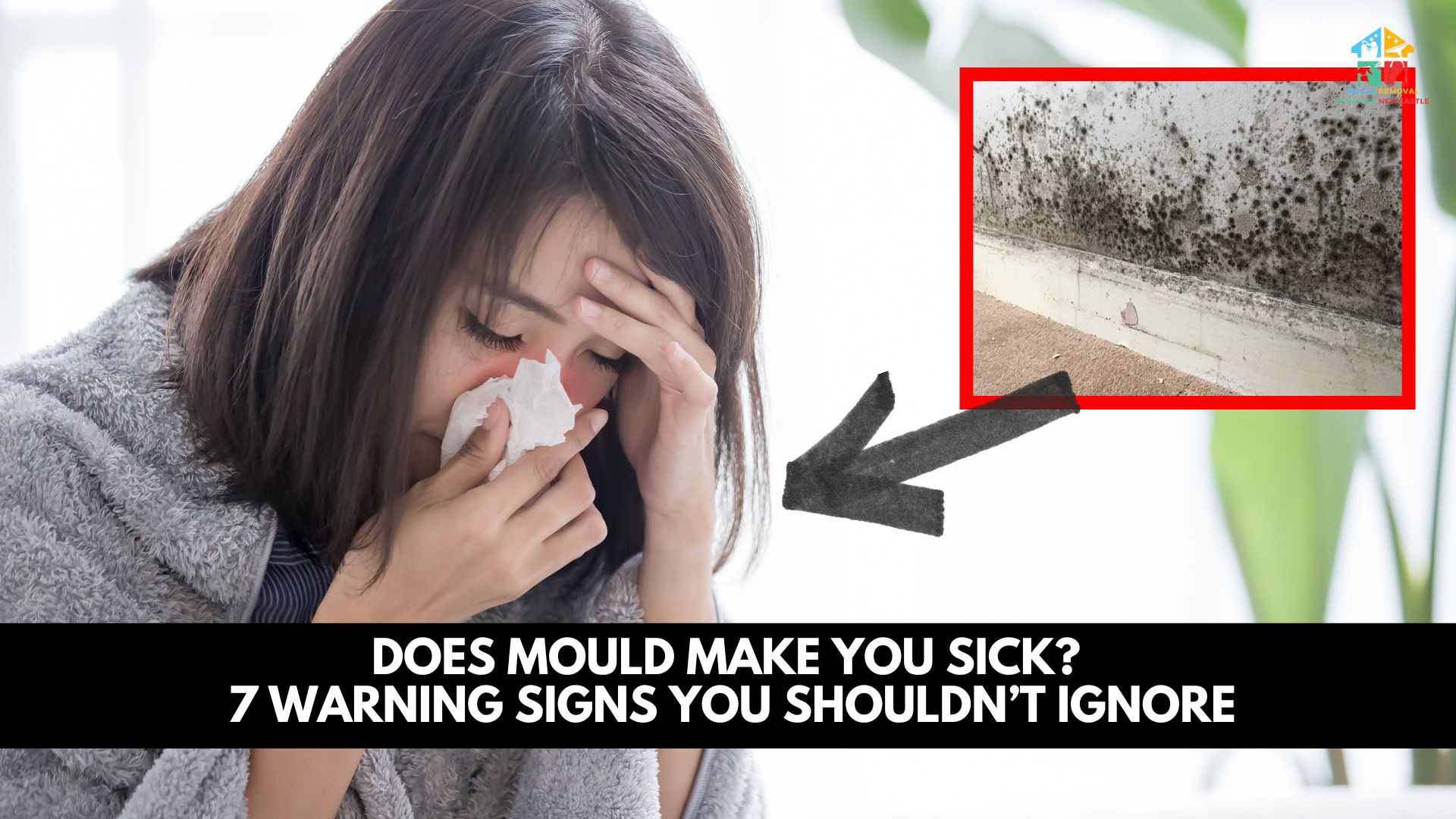Yes, mould can seriously impact your health if left untreated. Mould produces tiny spores that float in the air and are easily inhaled, leading to a range of symptoms that often go unnoticed at first. Many people mistake mould-related illness for allergies, colds, or fatigue. Over time, exposure can trigger respiratory problems, headaches, or even chronic inflammation. Understanding how mould affects your body is the first step toward protecting your home and wellbeing.
What Is Mould and Why Does It Grow Indoors?
Mould is a type of fungus that thrives in damp, poorly ventilated areas. It grows on walls, ceilings, and floors where moisture builds up from leaks, condensation, or high humidity. Common areas include bathrooms, kitchens, and basements. When mould spreads, it releases spores that can travel through the air and settle on other surfaces. Keeping your home dry and well-ventilated is key to preventing its growth.
How Does Mould Release Spores That Affect Your Body?
Mould reproduces by releasing microscopic spores that you can’t see but easily inhale. These spores contain allergens and toxins that can irritate your lungs, throat, and sinuses. Once inside your body, they can trigger inflammation and immune responses. People with asthma or allergies often feel these effects more strongly. Over time, continuous exposure can make even mild symptoms worse.
Are Certain Types of Mould More Dangerous Than Others?
Yes, some types of mould are more harmful than others. Black mould (Stachybotrys chartarum) is especially toxic and linked to more severe respiratory and neurological symptoms. Other types, such as Aspergillus and Penicillium, can also cause allergic reactions and breathing issues. The danger depends on the mould type and the length of exposure. Identifying the source early prevents serious health complications later on.
7 Warning Signs Mould Might Be Making You Sick
1. Are You Experiencing Persistent Coughing or Breathing Problems?
If you’re coughing or wheezing more often indoors, mould may be irritating your respiratory system. Spores can inflame airways, making it harder to breathe and triggering asthma-like symptoms. These effects often worsen in damp rooms or during rainy weather. People with pre-existing lung conditions are especially vulnerable. Taking note of where and when symptoms appear can help trace the cause.
2. Do You Often Feel Fatigued or Lightheaded Indoors?
Feeling constantly tired or lightheaded can be linked to mould exposure. When your body fights off airborne irritants, it uses extra energy and triggers fatigue. Some people experience brain fog or mild dizziness after spending time in mouldy environments. This is often mistaken for stress or lack of sleep. If you feel better when away from home, mould could be to blame.
3. Are Your Allergies Worse at Home Than Anywhere Else?
Worsening allergies while indoors can be a clear sign of mould contamination. Sneezing, congestion, and itchy eyes that appear mainly at home are common symptoms. Mould spores act as airborne allergens that irritate the nose and throat. Unlike seasonal allergies, these symptoms persist year-round. Checking damp areas of your home can reveal where the spores are coming from.
4. Have You Noticed Itchy Eyes, Skin Rashes, or Sinus Issues?
Skin and eye irritation can develop when mould spores land on exposed areas. Some people notice redness, itching, or sinus pressure after prolonged exposure. Sensitive individuals may also develop mild rashes or inflammation. These reactions are the body’s way of responding to toxins and allergens. Addressing indoor moisture problems can often relieve these symptoms quickly.
5. Do You Keep Getting Unexplained Headaches?
Frequent headaches may indicate that you’re reacting to mould toxins. Poor air quality and ongoing irritation in the sinuses can trigger tension or migraine-like pain. These headaches often fade after leaving a contaminated space. Dehydration or low ventilation can make the problem worse. If headaches are paired with other allergy-like symptoms, mould is a likely cause.
6. Is Anyone in Your Home Developing Unusual Sensitivity to Smells?
A growing sensitivity to odours, especially musty ones, can signal mould exposure. Spores can heighten your sense of smell or cause nausea when you encounter strong scents. This happens because the body’s immune system becomes more reactive over time. The smell of dampness or decay is often the first visible clue of a mould issue. Paying attention to how people respond to these odours can help locate hidden growth.
7. Are Your Symptoms Improving When You Leave the House?
If you feel better when you’re away from home, it’s a strong indication that the environment is affecting you. Many people notice relief from coughing, congestion, or fatigue after being outdoors. This difference shows that something inside the property, often mould, is triggering the symptoms. Once the affected area is cleaned and dried properly, health usually improves quickly. Noticing these patterns can help confirm whether mould is the source.
What Conditions Can Mould Exposure Make Worse?
Mould exposure can worsen existing respiratory conditions like asthma, bronchitis, and sinus infections. It can also increase the risk of chronic fatigue, joint pain, or skin irritation. Over time, immune responses become less effective, leading to more frequent illness. Those with allergies or weakened immunity are most affected. Identifying and removing mould early prevents long-term harm.
Can Mould Affect Children and the Elderly More Severely?
Yes, young children and older adults are more vulnerable to mould-related illness. Their immune systems are either still developing or less active, making it harder to fight off spores. In children, prolonged exposure can lead to persistent coughs, skin rashes, or breathing difficulties. Elderly individuals may experience worsened asthma or increased fatigue. A mould-free home environment is especially important for their health.
How Long Does It Take for Mould to Affect Your Health?
The effects of mould can appear within days or build gradually over months. Short exposure may cause mild symptoms like sneezing or irritation, while long-term exposure leads to more severe health issues. Factors such as humidity, mould type, and individual sensitivity all play a role. Because symptoms mimic other conditions, they are often overlooked. Regular inspection of damp areas helps prevent prolonged exposure.
How Can You Tell If Mould Is Growing in Hidden Areas of Your Home?
Mould often hides behind wallpaper, under flooring, or inside ventilation ducts. Signs include a musty smell, peeling paint, or discoloured patches on walls and ceilings. Condensation on windows and persistent dampness can also point to unseen growth. Using a moisture meter or hiring professionals can confirm hidden mould. Early detection prevents both health issues and costly damage.
Can Cleaning Alone Solve a Serious Mould Problem?
Basic cleaning can remove surface mould, but it rarely addresses the root cause. Without eliminating moisture sources, mould quickly returns. Store-bought sprays may provide short-term results but fail to remove spores deeply embedded in materials. Proper removal requires drying, cleaning, and restoring affected areas. Long-term prevention depends on tackling leaks and improving ventilation.
When Should You Call a Professional Mould Removal Team?
Professional help is needed when mould covers large areas or keeps returning after cleaning. Experts can assess the extent of contamination and use safe removal techniques. They also identify underlying moisture problems that cause regrowth. Timely intervention prevents further damage to walls, insulation, and air quality. Knowing when to call for help ensures your home stays safe and healthy.
How Can Mould Removal Newcastle Help Protect Your Home and Health?
Mould Removal Newcastle provides trusted mould inspection and certified removal services tailored to your home’s needs. The team uses safe and effective methods to eliminate spores while preventing future growth. Each treatment focuses on restoring clean air and long-term protection. With professional guidance, you can maintain a safe living environment for your family. Reliable expertise ensures lasting results and peace of mind.
Don’t Ignore the Signs! Act Before It Gets Worse
Mould exposure is more than an inconvenience; it’s a real health concern that should never be ignored. Recognising the early warning signs allows you to act quickly and prevent long-term damage. Cleaning visible mould is only part of the solution; removing moisture and improving ventilation are just as important. With proper care, your home can stay healthy and mould-free. Taking action now ensures a cleaner, safer space for everyone inside.





